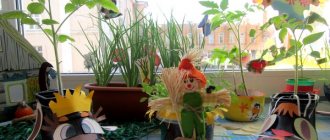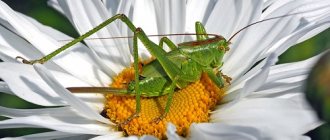Educational research project in the senior group. Green pharmacy
Educational and research project on ecology in kindergarten “Green Pharmacy”.
Senior group Type of project: By focus:
educational and information project
By number of participants:
group, subgroup.
By duration:
medium duration (1-2 weeks)
Project participants: • Children of the senior group • Educators • Parents Relevance “There is great power in herbs and words,” says an old Latin proverb. The properties of plants are wonderful and varied. The ability to love nature does not come on its own. The basis of children's conscious attitude towards nature should be knowledge about it, which is presented to children by adults in a vivid emotional form. And here a lot depends on the ability of an adult to teach children to recognize each plant and protect it. Observing and examining plants in the summer, on the street, in the meadow, in the garden, in the forest, the teacher’s task is to create conditions for introducing children to the world of medicinal plants of our region, to form ideas about the role of plants in the improvement and preservation of human health, therefore an ecological project "Green Pharmacy". Goal: To familiarize children with the most common medicinal plants of the Chelyabinsk region. Main objectives of the project: 1. Strengthen the ability to recognize and name medicinal plants (4-6 species). 2. Expand knowledge about the benefits and use of medicinal plants. 3. Introduce children to the rules of conduct when collecting medicinal plants. 4. To consolidate children’s knowledge about the structure, components, distinctive features of each type of plant, and use in food. 5. Develop skills: observe, compare, analyze and reflect on the results of observations in different types of creative activities (theatrical, gaming, musical, artistic, productive). 6. Enrich children's vocabulary and their knowledge about medicinal herbs. 7. Develop cognitive activity, thinking, imagination, communication skills, independence, hard work, observation and curiosity for all living things. 8. Foster a caring attitude towards nature, the natural heritage of our region, and involve in environmental activities. Expected result: During the implementation of this project, children will learn not only the names of medicinal plants and their appearance, but also their medicinal qualities.
Through research, they will become familiar with the properties of medicinal plants and the peculiarities of their vital functions. In the process of work, the development of cognitive processes, feelings of empathy, and communication skills will naturally occur, aimed not only at conflict-free communication between children and each other, but also at caring for nature in general. Download Educational and research project “Green Pharmacy”
We recommend watching:
Project in kindergarten for older preschoolers 5-7 years old on legal topics Project in the senior group of kindergarten Project in the senior group on the topic “Trees and shrubs in spring” Ecological and valeological project in kindergarten in the senior group
Similar articles:
Project for children of the senior group “Our cheerful garden”
Pharmacy garden: medicinal plants in the country
Most medicinal plants grow wild, so they are extremely unpretentious. So they will definitely like it on your site. But they are also beautiful, so their decorative “component” can be used in garden design. Finding medicinal plants is not difficult; take a closer look at what grows outside the perimeter of your site, or in the nearest forest or field. Carefully dig up the rhizomes of wild herbs and transplant them to your plot, but garden medicinal plants can be sown with seeds.
Here are some universal medicinal plants that can be planted on the site:
Peppermint and field mint Peppermint and field mint You will not have any problems growing mint. The only thing that needs to be done is to limit the area of distribution of this plant: you can dig a large container or box into the ground, or limit some area using slate. Mint can be propagated by seedlings, sowing the seeds as early as possible, or by dividing the bush if you or your neighbors already have this plant. Peppermint has a choleretic effect, and field mint has an antispasmodic effect .
Both mints also have a slight relaxing effect.
Melissa Melissa Melissa is a lemon balm and its leaves have a lemon scent. Unlike peppermint and field mint, its strong point is just a relaxing and somewhat hypnotic effect .
Oregano Oregano Be sure to get this medicinal plant, it is not only beneficial, but also a wonderful aroma that you will enjoy in your garden. The medicinal properties of oregano are increased secretion of various glands of the body, including increased peristalsis and intestinal tone .
The plant is quite strong, so oregano is not recommended during pregnancy. In general, oregano has a calming effect on the central nervous system.
Monarda Monarda This beautiful plant is sometimes called "bergamot" because the smell of monarda leaves mimics the smell of bergamot. You can even make your own bergamot tea by mixing any tea with fresh monarda leaves and waiting two weeks for the leaves to dry and impart their aroma to the tea. Most people consider monarda to be a herb, but it is also a medicinal plant. The decoction (or tea to which monarda leaves are added) is very beneficial for digestion. But its main use is skin. Monarda treats wounds, skin infections, and is also an anti-allergic skin remedy and helps with eczema and psoriasis .
Thyme Thyme Thyme has many varieties, but they are similar in properties. And it has a place not only on an alpine hill, but also in a pharmacist’s garden. For medicinal purposes, leafy twigs are collected during the period of full flowering. Thyme has a bactericidal and antifungal effect .
Elecampane Elecampane This plant is somewhat similar to buzulnik. Its yellow flowers are collected in large, few baskets 7–8 cm in diameter, and the leaves are large, elliptical. The plant is tall, up to 1.5 m tall. A decoction of elecampane relieves spasms of the gastrointestinal tract and enhances the formation of bile . In addition, it is used for chronic respiratory diseases: bronchitis and tracheitis .
Salvia officinalis Salvia officinalis This is a subshrub with numerous stems, with dense small gray-green leaves and a spike-shaped inflorescence consisting of many light purple flowers. People also call it “gorlyanka”. And indeed, it specifically treats the throat . An infusion of sage leaves is used for inflammatory processes in the oral cavity and pharynx, including sore throats.
St. John's wort St. John's wort Who doesn't know St. John's wort! And, by the way, it is quite an ornamental plant; there is even a specially bred garden St. John's wort, which is larger than the field one. St. John's wort infusion is used as an astringent, disinfectant and anti-inflammatory agent for diseases of the gastrointestinal tract, mainly acute and chronic colitis . It is also a good immunomodulator and an excellent natural antidepressant .
When using the medicinal properties of St. John's wort, you need to remember that it is undesirable to take infusions from it on hot sunny days, since this herb is photosensitive - you can immediately get burned.
Calendula officinalis Calendula officinalis (marigolds) Calendula officinalis is often planted in summer cottages for decorative purposes: in flower beds, borders, modules, and containers. But in addition to its bright “appearance,” calendula has a number of valuable properties: firstly, it is a good antiseptic ; a decoction of flowers can be used in the treatment of cuts and burns. It is also an excellent remedy for stomatitis and gingivitis . However, many people know about the anti-inflammatory properties of calendula. But not everyone knows, but calendula is an excellent remedy for diseases of the gastrointestinal tract: gastritis, colitis, enterocolitis and gallbladder diseases .
Calendula decoction is also used in the treatment of heart diseases accompanied by palpitations, shortness of breath and swelling.
Fireweed Fireweed (Ivan-tea) Tall and bright plant. A decoction of Ivan tea has a tranquilizing property similar to valerian , as well as anti-inflammatory and enveloping effects due to the tannins contained in the plant. It is effective to use a decoction of Ivan tea for stomach ulcers, gastritis and colitis .
Medicinal chamomile Medicinal chamomile Medicinal chamomile is no less decorative than garden chamomile, only this version is in miniature. Well, if there is a lot of this chamomile, the beauty is unprecedented. Any “daisies” bloom for a long time, have repeated blooms and last a long time in bouquets. Everyone probably knows about the properties of chamomile - it relieves spasms and has an antimicrobial effect . It is also used for cosmetic purposes - for example, chamomile decoction strengthens hair and lightens it a little.
If you wash your face with chamomile decoction, you can get rid of acne.
Yarrow Yarrow Yarrow is used in garden design mainly in its “colored” versions, but ordinary white is no worse. If we are talking about a country pharmacy. Yarrow has hemostatic properties and also affects the flow of bile . It has certain antiarrhythmic properties (when the juice of the leaves is used).
Being included in herbal teas, it enhances their effect.
Jerusalem artichoke Jerusalem artichoke This tall flower, generally similar to a sunflower, is also called the earthen pear. Because, unlike sunflower, it has an edible root, or rather special nodule formations. Very tasty dishes are prepared from Jerusalem artichoke nodules, and the good thing about it is that it can be harvested in November and even in March, that is, when there is nothing else in the garden. Jerusalem artichoke has an antidiabetic effect, and is good for both the treatment and prevention of diabetes .
Snake knotweed Snake knotweed Its popular name is crayfish necks. Its pink plumes on thin stems usually decorate garden ponds. “Officially” it refers to ornamental plants for the garden. And not everyone knows that it is a medicinal plant. And what else. But not inflorescences or leaves, but rhizomes. The decoction has astringent properties and is used for acute and chronic intestinal diseases, as well as for stomatitis and gingivitis .
Schisandra chinensis Schisandra chinensis Most summer residents are probably familiar with it, because it is an excellent option for vertical gardening for trellises, pergolas, fences, it is absolutely unpretentious and always beautiful: the leaves, flowers, and berries are very decorative. Schisandra chinensis has medicinal berries, leaves and roots. The berries have a strong tonic effect . They say that before, the indigenous inhabitants of the Far East, when going hunting, took with them only a few lemongrass berries, and thanks to this they did not feel tired and could not sleep at night. Therefore, it is not recommended to eat lemongrass berries in large quantities. A tincture is prepared from the roots of lemongrass in the medical industry and is sold in pharmacies. It is a tonic and immunomodulatory agent . But not everyone knows that lemongrass leaves also have the property of increasing immunity, so they can be brewed during the flu and cold season.
Content
- 1 Author of the project
- 2 Subject, age of students
- 3 Brief summary of the project
- 4 Questions guiding the project 4.1 Fundamental question
- 4.2 Problematic issues
- 4.3 Study questions
Questions guiding the project
Fundamental Question
What medicinal plants from your native land can help you maintain and improve your health?
Problematic issues
Do you know the medicinal plants that grow in the Kurgan region?
What is the significance of medicinal plants for humans?
Why do medicinal plants need protection?
Study questions
1. What effect do medicinal plants have on the human body?
2. What is the future of green pharmacy in the face of increasing human impacts?
3. How can you help preserve medicinal plants in your area?
4. What proverbs, riddles, poems, works about medicinal plants do you know?
5. What applications will you use to design your projects?
6. How to create a presentation?
7. What is a presentation?


